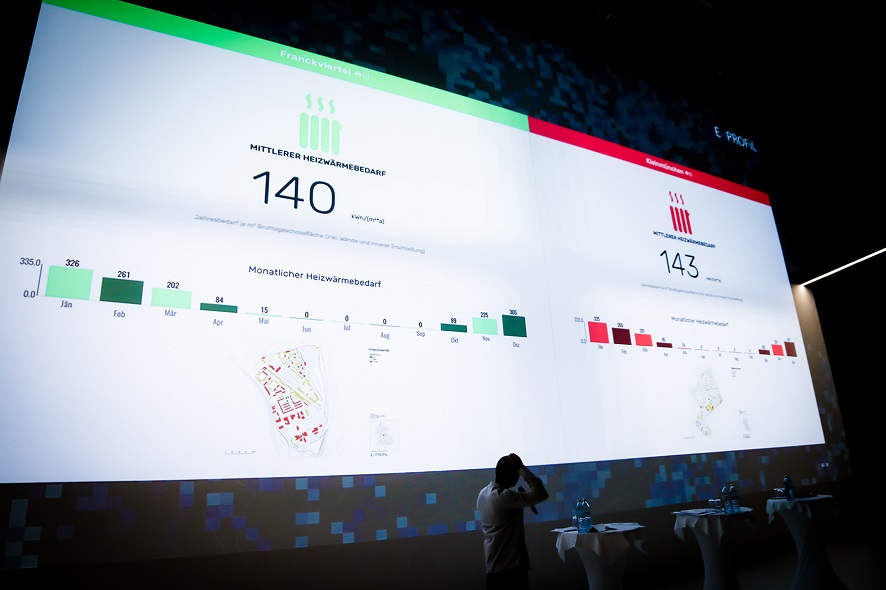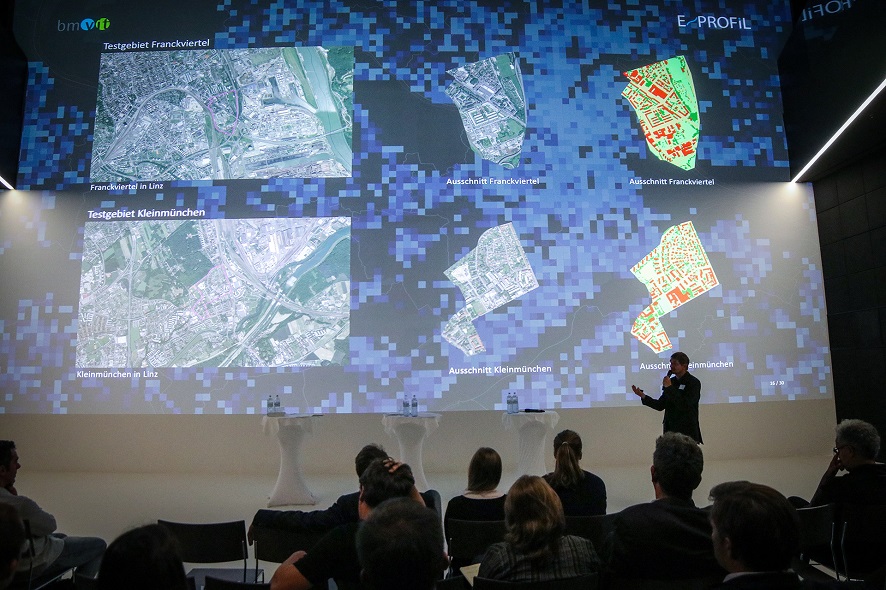The objective: Energy & resource efficient urban renewal. The strategy: Find the basis and instruments for an energy and resource efficient planning processes in urban areas. The name: E_PROFIL.
This initiative is powered by a group of partners and associates that includes the Ars Electronica Futurelab. The aim of this joint research project is to design the toolkit, E_PROFIL, that supports the energetical renewal of urban areas. Franckviertel and Kleinmünchen were the first Linz neighborhoods to be selected for E_PROFIL analysis. The data gathered thereby are serving as the basis for an instructional manual and a set of methods for subsequent research and planning.
We talked to representatives of the participating firms and institutions to learn more.

Credit: Ars Electronica Futurelab
[Rudolf Giffinger, Professor of Regional Science, Vienna University of Technology, Institute of Urban and Regional Research] Could you start off by relating how this project came to be?
Rudolf Giffinger: There’s no shortage of climate goals—those of the UN, the EU, and on federal and state levels—but these have to be implemented locally. In Austria in this connection, cities are particularly important because that’s where the most potential is. Research on how to make buildings more energy & resource efficient has been going on for quite a while. Our project’s point of departure was the idea that urban households already have wide-ranging experience with energy efficiency, retrofitting thermal insulation and switching to renewable energy sources, and there’s ongoing interest in additional projects. Then, we looked into whether a city neighborhood is the right level on which to organize the implementation of energy projects, and our answer was a resounding YES! The principles and tools this project is developing are a key contribution to this effort.
[Di Daniel Latzer, Professor, Vienna University of Technology, Institute of Urban and Regional Research] Please explain why neighborhoods are the right focal point for this project. And why did you select these two Linz neighborhoods?
Daniel Latzer: One of the advantages of a neighborhood-by-neighborhood approach is that this is a “manageable” entity, so it has just the right size to take advantage of the mutual familiarity and trust that characterize the relationships among people and organizations within a part of town. Locals are aware of existing communications channels and previously implemented projects. A neighborhood focus simplifies getting concrete energy projects off the ground. In this way, projects and initiatives can be implemented more easily and effectively.
The consortium chose the Franckviertel and Kleinmünchen neighborhoods on the basis of information provided by municipal agencies. Due to their urban development characteristics, these areas offer many different potential ways to save energy; at the same time, they’re characterized by divergent interests due to their social makeup.
[Dr. Gerhard Utri of the City of Linz’s Department of Planning, Technology and the Environment] What are the City of Linz’s expectations from this project?
Gerhard Utri: The focus of the E_PROFIL project is on providing a tool to modernize the way energy is used in a neighborhood while taking the needs of providers and consumers into account. This toolkit is designed to serve as an instrument to facilitate decision-making on occasionally touchy political issues such as those that arise in conjunction with renovating buildings and whether to switch to other—preferably renewable—energy sources. Moreover, this project isn’t custom-tailored to particular cities (like, for instance, the city lab model is); it can be applied in a variety of urban settings, at least in Europe. The essential way to achieve this is by not simply describing the characteristics of individual neighborhoods but rather by elaborating and standardizing the individual steps from planning and conceptualizing to implementation and monitoring. The pilot project was carried out in two Linz neighborhoods, Franckviertel, and a section of Kleinmünchen. There’s no denying that this effort entails challenges—besides the availability of data, above all the political will to implement the findings and finance this process.

Credit: Ars Electronica Futurelab
[Hannes Schaffer, CEO of mecca consulting, an engineering practice specializing in regional & landscape planning]. What do you see as the main challenges of getting involved in a project of this magnitude in this field?
Hannes Schaffer: Reconfiguring energy delivery to an entire neighborhood is a complex process that is subject to overriding agendas and thus has to take into consideration very diverse interests and protagonists with varying expectations of what this neighborhood should offer—investors, developers, property owners, residential & commercial users, and outside observers. A precondition for successful implementation is an intensive learning phase and negotiations involving all stakeholders, whereby the decision-making should proceed in step-by-step fashion and entail participative determination of the measures to be implemented. Stakeholders ought to be identified and contacted as early as possible, and it’s highly advisable to take advantage of extant networks on the municipal and neighborhood levels.
[Prof. Verena Madner, head of the Research Institute for Urban Management and Governance at the Vienna University of Economics and Business] What’s your take on this project and the legal challenges it faces?
Verena Madner: The E_PROFIL project focuses on a substantive field that is very significant in actual practice. Discussions of energy efficiency in an urban setting often concentrate exclusively on new construction. The E_PROFIL project, however, focuses on existing structures and sheds light on how best to go about renovating them to achieve energy efficiency. The project staff’s interdisciplinary collaboration has yielded many new insights. From a legal point of view, it has shown, above all, that the right of residence in a particular property often doesn’t deliver the right incentives to carry out a renovation. It has also been clearly shown that current zoning regulations and financial subsidy provisions in Austria have no bearing on a specific neighborhood. In particular, this project has demonstrated that an ombudsman in the form of a neighborhood-based facilitator can contribute a great deal to consensual implementation and success of renovation projects.
So, have the project’s objectives been attained and where do we go from here?
Rudolf Giffinger: One of the project’s aims has been to investigate the local conditions for neighborhood renewal and to develop a versatile toolkit for use on the neighborhood level. In addition to the scholarly reports, the results and the toolkit have been assembled in a “Guide for Refurbishment to Achieve Energy Efficiency” and put online at http://www.eprofil.at/. The next step is to try out this toolkit in other neighborhoods throughout Austria.
[Nicolas Naveau, head of the Ars Electronica Futurelab team that designed the presentation of the E_PROFIL results] What demands did the visualization process have to satisfy?
Nicolas Naveau: Our assignment was to develop an online tool to easily display databases as familiar types of graphics—for example, to convert figures into pie charts or bar charts. And the tool has to be user-friendly for both experts and laypeople.
The key is for users to be able to quickly visualize all types of content in terms of graphics that employ familiar iconography. That’s why recourse to knowledge that is widespread among the general public was a logical approach to the visualization. All the icons such as houses and people have been custom-designed but they draw upon a familiar, generally accepted symbolic vocabulary.
Thanks to the combination of backend algorithms (from the datasets of the test neighborhoods) and the live generation of benchmark results following input by the users, the complexity of the functions is reduced considerably without sacrificing precision.
The results of the E_PROFIL research project and the data from Frackviertel and Kleinmünchen are available on the E_PROFIL website. You can download the final report here.
To learn more about Ars Electronica, follow us on Facebook, Twitter, Instagram et al., subscribe to our newsletter, and check us out online at https://ars.electronica.art/news/en/.
